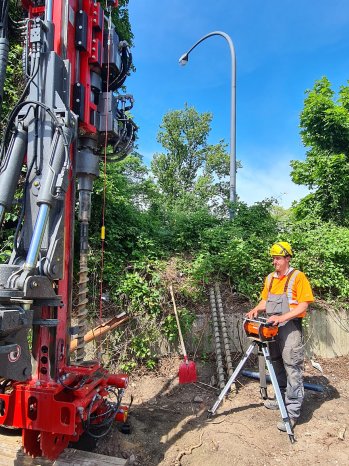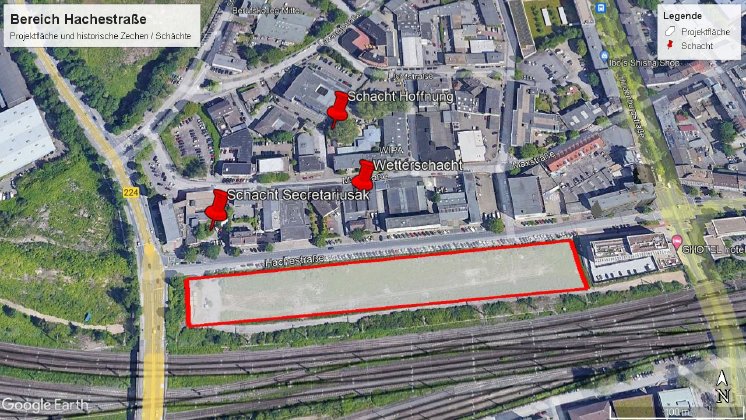In more than 700 years of mining, - including all small mines - there were about 1,300 mines- - in the Ruhr area. There were around 280 in both Bochum and Essen alone, plus about 250 in Sprockhövel and about 120 in Dortmund. Until the introduction of the "Prussian Mining Law" in 1865, mine owners were not obliged to map their mining operations and submit them to the Mining Authority. All mining activities before that time are therefore poorly documented or, in some cases not documented at all. In the post-war period, illegal mining also took place in some areas, leaving more undocumented unfilled cavities. The total number of openings and tunnels in the southern Ruhr region alone is estimated at around 60,000[ii], of which only about 27,000 have been recorded or discovered to date - only a fraction of these have been backfilled and secured. The problem zones with acute dangers due to sinkholes are located in particular where mining was only carried out to a depth of 100 meters.
As if this were not enough, the bombing by the Allies during World War 2 also left thousands of unexploded bombs underground, which have remained undiscovered to this day. According to a report by the press office of the NRW state government, 1.3 million tons of explosives were dropped on the territory of the Deutsche Reich during World War 2. About half of the air raids were concentrated in what is now North Rhine-Westphalia, and a high percentage of these were focused on the cities with their infrastructure and industrial facilities between the Rhine and Ruhr rivers. Experts[iii] assume that about 15 percent of the bombs were unexploded bombs and therefore up to 100,000 tons are still hidden undiscovered in the ground throughout Germany at a maximum depth of 8 meters, depending on the weight, size and subsoil. In North Rhine-Westphalia alone, between 2,000 and 2,500 bombs are discovered and cleared each year. In Essen, which was particularly hard hit, it is assumed that of the 14,000 unexploded ordnance suspected there, only a good half could be found and defused during the war and reconstruction. This means, that there are thousands more lying hidden underground - not counting grenades, hand grenades and mines. All of the unexploded ordnance, as well as the near surface mining, pose very special dangers. In the affected areas, special precautions must therefore be taken even before the start of construction work. The owner is responsible for ensuring that a construction site is free of explosive ordnance, and the legal successors of the mining companies - if known or still in existence - are responsible for locating and removing old mining contamination. If no legal successor can be identified, the state of North Rhine-Westphalia takes over.
When evaluations of old documents or aerial photographs reveal suspected explosive ordnance, the first step is usually to probe from the surface using ground penetrating radar, geo-magnetic, or electromagnetic systems. Depending on the soil conditions, however, these methods only provide reliable results down to a depth of 3 meters, or in exceptional cases up to 5 meters. If no hits are found here, depth probing can be started. A classic method for locating unexploded bombs at depths of up to 15 m and above, is geomagnetic depth probing, in which ferromagnetic bodies (iron) are detected at an average radial distance of 0.75 m from a borehole. This is also the case on a current construction site of Company “GbE Grundbau Essen GmbH” near Essen's main train station. Two office buildings and a parking garage will soon be built on the approximately one-hectare site on Hachestraße, where the railroad freight terminal used to be located.
Here, the latest generation of a KLEMM KR 801-3GS drilling rig is used to drill 27 boreholes in a specified grid down to 8 meters below ground level - the ground level at the time of the end of the war in 1945. The boreholes are drilled using the so-called auger drilling method without flushing. This is because percussive drilling methods with hydraulic drifters or dth-hammers are generally not permissible here due to the risk of explosion caused by vibrations from any unexploded ordnance that may be present. The boreholes have a diameter of 120 mm, into which a PVC pipe is installed after completion to stabilize the borehole for subsequent travel with the ferromagnetic probe. "As a drilling operator, you have to have a lot of experience here in order to correctly interpret the invisible processes in the borehole - just on the basis of the rotation and feed behavior, as well as the resulting noises during drilling," reports Timo Hölscher, the drilling operator in charge at GbE. "Of course, no one wants to risk drilling into an unexploded ordnance and thus causing it to explode - but a certain residual risk can never be completely ruled out. The precise and sensitive control of the KR 801-3GS already makes my work considerably easier, and the wireless remote control means that I'm not usually standing right next to the borehole," continues Hölscher. Once all the boreholes have been completed, the measurement is carried out by lowering the measuring probe (e.g. a vertical gradiometer) into the plastic pipe. The measurement data obtained in this way is later evaluated by specialists on the computer. Depending on the result, the ground is then either released, or further necessary measures are taken if required.
If there are indications of old mining activities, exploratory drilling is carried out immediately, provided that contamination with explosive ordnance can be ruled out. In this case, boreholes are also drilled in a defined grid using a flushing drilling method. Contrary to explosive ordnance exploration, this can also be carried out using the percussive drilling method, if the subsurface requires it. Hits, or rather tapped cavities, are recognized by the drilling specialists either by the sagging of the drill string or by the drying up of the mud flow. The size, location and course of the cavities are then determined and mapped by further drilling in the vicinity of a hit. If necessary, a plastic pipe is also inserted into these boreholes, through which the cavity is backfilled with cementitious building materials after the drilling work is completed. "A few thousand cubic meters of fill material can accumulate on a construction site," reports T. Hölscher. Depending on the intended later use, additional injection boreholes may be drilled to inject grout for further stabilization of the foundation soil via sleeve pipes.
The construction site on Hachestraße is located in the direct neighborhood to the shafts of 3 historic underground coal mines :
- Mine "Secretarius Aak" - mining about 1750 to 1805 in 50 m distance
- Mine "Vereinigte Hoffnung und Sect. Aak“ shaft “Hoffnung" - mining activities from 1805 to 1897 in 150 m distance
- Mine "Vereinigte Hoffnung und Sect. Aak“ ventilation shaft in seam “Röttgersbank" in 40 m distance
The KR 801-3GS used here defines its own class of especially compact and, at the same time, universally applicable drilling rigs. Mounted on oscillating tracks, the drilling rig is ideal for almost all jobs encountered in special civil engineering - from light to heavy drilling works. Equipped as standard with a power-optimized hydraulic system (KLEMM "Power Sharing"), the Energy Efficiency Package (KLEMM "EEP"), adaptive rpm control of the engine and fan, and effective sound insulation hoods, the unit, with its low emission values is also ideally suited for inner-city use. The ergonomic design, easily maintainable, fail-safe machine control with remote diagnostics, remote control operation, and extensive safety features round off the package.
Despite the modern machines and processes available today, the search for, and removal of, the relics of war and mining will remain an eternal task for many generations to come on the Rhine and Ruhr.
Wikipedia: list of mines in North Rhine Westphalia (https://de.wikipedia.org/...)
[ii] div. publications of the district government Arnsberg
(https://www.bra.nrw.de/...)
[iii] Press release from the state NRW
(https://www.land.nrw/...)
[iv] Report on „derwesten.de“ dated 27.11.2013
(https://www.derwesten.de/...)





